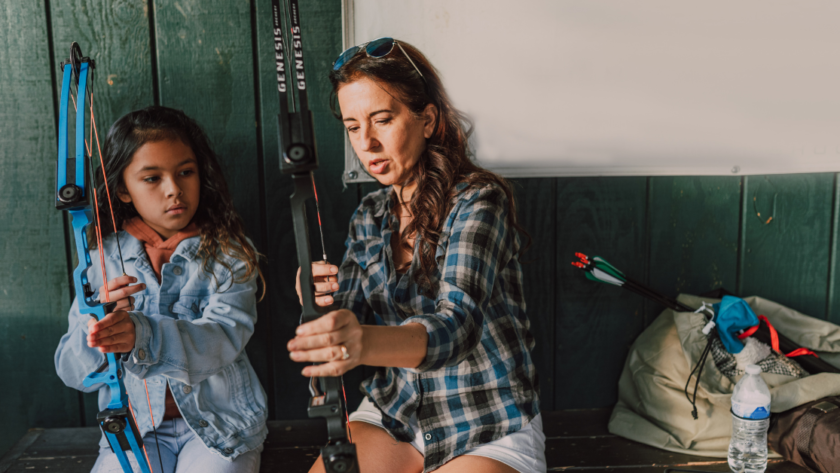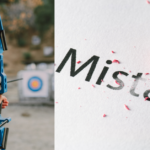As an avid archer and instructor, I’ve seen countless newcomers step onto the range for the first time. The excitement of nocking that first arrow and feeling the bow’s tension is truly unmatched. But before you let that arrow fly, we need to talk about safety.
I’ll never forget my first time at the range. In my eagerness to start shooting, I nearly forgot to put on my arm guard.
Thankfully, a seasoned archer nearby gave me a friendly reminder.
That moment taught me a crucial lesson: in archery, safety always comes first.
Whether you’re drawn to archery for sport, hunting, or as a hobby, mastering safety basics is essential. These guidelines will help you enjoy archery’s thrill while keeping everyone safe and sound.
The Golden Rules of Archery Safety
Always Treat Your Bow as if It’s Loaded
Just like with firearms, the first rule of archery safety is to treat every bow as if it’s ready to shoot. This mindset keeps you constantly aware and helps prevent accidents.
Even when you’re sure the bow isn’t strung or nocked, handle it with care and respect.
Never Dry Fire
Dry firing – releasing the bowstring without an arrow – can severely damage your bow and potentially cause injury. Always confirm an arrow is properly nocked before drawing the bow.
If you accidentally draw without an arrow, slowly and carefully release the tension on the string.
Use Proper Targets and Backstops
Shooting at improvised targets might seem fun, but it’s dangerous. Always use targets designed for archery and confirm there’s an adequate backstop to catch stray arrows.
This prevents property damage and reduces the risk of injury to others.
Essential Protective Gear
Arm Guards: Your First Line of Defense
An arm guard protects your forearm from the sting of the bowstring. Trust me, you don’t want to experience string slap without one.
It’s not just painful – it can affect your shooting form and accuracy.
I once saw a beginner skip the arm guard, thinking it wasn’t necessary. After one painful shot, they quickly changed their mind.
The welt on their arm served as a reminder for weeks.
Finger Tabs or Releases: Saving Your Digits
These protect your fingers from the friction of the bowstring. Finger tabs are great for beginners, while mechanical releases are often preferred by more advanced archers, especially those using compound bows.
When I first started, I underestimated the importance of finger protection. After a long practice session, my fingers were raw and sore.
Now, I never shoot without proper finger protection.
Eye Protection: Don’t Overlook It
While not always mandatory, eye protection is highly recommended. It shields your eyes from potential debris and provides an extra layer of safety. I’ve seen a bowstring snap unexpectedly – the archer’s safety glasses likely saved them from serious eye injury.
Mastering Proper Form
Developing proper archery form is not about improving accuracy – it’s a crucial aspect of safety. Here’s what to focus on:
Stance
Keep your feet shoulder-width apart, perpendicular to the target. This provides a stable base and helps prevent you from accidentally stepping into the path of your arrow.
Bow Arm
Maintain a slight bend in your elbow to avoid hyperextension. A locked elbow can lead to injury when the bowstring is released.
Anchor Point
Consistently draw to the same point on your face. This improves accuracy and ensures you’re not drawing the string back too far, which could lead to injury.
Follow-Through
After release, allow your hand to move naturally backward. Proper follow-through helps maintain consistency and prevents you from flinching or moving in a way that could affect the arrow’s path.
Range Etiquette and Commands
Understanding and following range rules is non-negotiable. Here are some universal guidelines:
- Always follow the range officer’s commands immediately.
- Never nock an arrow until you’re at the shooting line and the range is clear.
- Only retrieve arrows when given the signal to do so.
- If you drop an arrow, leave it until the end of the shooting round.
I once seen a new archer ignore the cease fire command because they wanted “just one more shot.” The range officer quickly intervened, explaining how dangerous this behavior could be. It was a sobering moment for everyone present.
Equipment Inspection: A Crucial Habit
Before each shooting session, take a few moments to inspect your equipment:
- Check your bowstring for fraying or wear.
- Examine arrow shafts for cracks or splinters.
- Ensure nocks and fletching are securely attached.
- Verify that your bow’s limbs are free from cracks or damage.
This simple routine can prevent equipment failure and potential injuries. I make it a habit to inspect my gear while I’m setting up, so it becomes a natural part of my preparation process.
Common Pitfalls for Beginners
Overestimating Shooting Distance
Start close to the target and gradually increase distance as you improve. I’ve seen many beginners try to shoot from too far away, leading to missed targets and potentially lost arrows.
Neglecting to Use a Quiver
Always use a quiver to safely store arrows when not shooting. Carrying arrows in your hand or sticking them in the ground is a recipe for accidents.
Improper Bow Hand Grip
Avoid gripping the bow too tightly – a relaxed grip improves accuracy and safety. I teach my students to imagine they’re holding a delicate bird – firm enough to keep it from escaping, but gentle enough not to harm it.
Shooting from Unstable Positions
Always confirm you have stable footing before drawing your bow. Uneven ground or slippery conditions can lead to falls or misfires.
Adapting to Different Archery Disciplines
As you progress, you might explore different types of archery. Each discipline has it’s own safety considerations:
Field Archery
Be extra aware of your surroundings and potential hazards in natural settings. Watch for uneven terrain, low-hanging branches, and wildlife.
3D Archery
Ensure clear shooting lanes and be mindful of others on the course. Always know what’s beyond your target.
Indoor Archery
Pay attention to close quarters and follow strict lane discipline. Be aware of other archers and spectators around you.
Building on the Basics
Mastering these safety fundamentals sets the stage for more advanced techniques. As you progress, you’ll find that good safety habits become second nature, allowing you to focus on improving your skill and enjoying the sport to it’s fullest.
Practice Exercises
Dry Practice
Without an arrow, practice your draw and anchor point in front of a mirror to perfect your form. This helps build muscle memory without the risk of accidental release.
Equipment Check Drill
Time yourself inspecting your equipment. Try to beat your time while maintaining thoroughness.
This helps make equipment checks a quick, effective part of your routine.
Range Command Reaction
Have a friend call out random range commands and practice responding quickly and correctly. This prepares you for real range situations and helps ingrain proper safety responses.
Advanced Safety Considerations
Understanding Your Bow’s Draw Weight
Choosing the right draw weight is crucial for safety and proper form. Starting with too heavy a draw weight can lead to poor technique and potential injury.
I always recommend beginners start with a lower draw weight and gradually work their way up as they build strength and skill.
Proper Arrow Selection
Using the fix arrows for your bow is essential for safety and performance. Arrows that are too short can fall off the arrow rest during draw, potentially leading to dry fire.
Arrows that are too light for your bow’s draw weight can also be dangerous.
Always ask with an experienced archer or pro shop when selecting arrows.
Maintaining Your Equipment
Regular maintenance of your bow and arrows is crucial for safety. This includes:
- Waxing your bowstring regularly
- Checking and tightening all screws and bolts
- Replacing worn-out parts promptly
- Storing your equipment properly to prevent damage
I set aside time each month for a thorough equipment check and maintenance session. It’s a great way to catch potential issues before they become safety hazards.
Safety in Different Shooting Environments
Outdoor Range Safety
When shooting outdoors, be aware of changing weather conditions. Wind can affect arrow flight, and wet conditions can make footing treacherous.
Always have a plan for sudden weather changes, including a safe place to store your equipment.
Backyard Practice Safety
If you’re fortunate enough to have space for backyard practice, take extra precautions:
- Ensure you have a proper backstop that can stop arrows
- Be aware of what’s beyond your target
- Inform neighbors of your practice to prevent surprises
- Secure your practice area to prevent unauthorized access
Hunting Safety
For those interested in bowhunting, extra safety measures are necessary:
- Always wear suitable safety harnesses when using tree stands
- Be aware of other hunters in the area
- Know your target and what’s beyond it
- Follow all local hunting regulations and safety guidelines
Teaching Archery Safety to Others
As you become more experienced, you may find yourself in a position to teach others. Here are some tips for effectively communicating safety principles:
- Lead by example – always follow safety rules yourself
- Explain the reasoning behind each safety rule
- Be patient and willing to repeat instructions
- Use positive reinforcement when students follow safety guidelines
- Address safety violations immediately and firmly
I find that sharing personal experiences or near-misses can be a powerful way to illustrate the importance of safety rules.
The Psychology of Archery Safety
Understanding the mental aspects of archery can contribute to better safety practices:
Focus and Concentration
Archery needs intense focus. Distractions can lead to safety lapses.
I teach my students to develop a pre-shot routine that helps them center their focus before each arrow.
Managing Frustration
Everyone has off days or struggles with certain aspects of archery. Learning to manage frustration is crucial for maintaining safety.
I encourage my students to take breaks when they feel frustrated, rather than pushing through and potentially making unsafe choices.
Peer Pressure and Safety
In group settings, there can be pressure to take risks or ignore safety rules. Building a culture of safety within your archery community is essential.
I always emphasize that safety concerns trump any perceived peer pressure.
Adapting Safety Practices as You Progress
As your skills improve, you’ll likely encounter new equipment and techniques. Each advancement brings new safety considerations:
Compound Bows
Moving from recurve to compound bows introduces extra mechanical elements. Understanding let-off, draw stops, and the increased power of compound bows is crucial for safe operation.
Release Aids
As you transition from finger release to mechanical releases, be aware of the increased sensitivity. Accidental releases are more common when first using these aids.
High-Speed Arrows
Modern archery equipment can produce arrow speeds far exceeding traditional bows. Understanding the increased penetration and potential for ricochet is important for advanced archers.
Creating a Personal Safety Checklist
Developing your own safety checklist can help confirm you never miss a crucial step. Here’s a sample checklist to get you started:
- Equipment inspection complete
- Proper protective gear worn
- Shooting area clear and safe
- Aware of all range rules and commands
- Mentally focused and free from distractions
- Physically prepared (warmed up, not fatigued)
- Weather conditions assessed (if outdoors)
- Emergency procedures known
Customize this list based on your specific needs and shooting environment. I laminated my checklist and keep it in my bow case for easy reference.
Dealing with Accidents and Emergencies
Despite our best efforts, accidents can happen. Being prepared for emergencies is an essential part of archery safety:
First Aid Knowledge
Basic first aid skills are invaluable in archery. Knowing how to treat minor injuries like cuts, sprains, or string slap can make a big difference.
I always keep a well-stocked first aid kit in my archery bag.
Emergency Action Plan
Every archery range should have an emergency action plan. Familiarize yourself with this plan, including:
- Location of emergency exits
- How to contact emergency services
- Location of first aid supplies
- Designated meeting points
Reporting Incidents
If you witness or experience a safety incident, always report it to range officials. This helps prevent future occurrences and can lead to improved safety measures.
The Role of Technology in Archery Safety
Advancements in technology have introduced new tools for enhancing archery safety:
Range Finders
These devices help confirm you’re shooting at suitable distances, reducing the risk of overshooting targets.
Bow-Mounted Cameras
Some archers use small cameras mounted on their bows to review their form and technique, which can help identify potential safety issues.
Arrow Tracking Devices
New technology allows archers to track lost arrows, reducing the risk of leaving dangerous projectiles in the field.
While these tools can be helpful, remember that they’re no substitute for solid safety practices and awareness.
Continuing Education in Archery Safety
Archery safety isn’t a one-time lesson – it’s an ongoing process. Stay informed about new safety developments:
- Attend safety workshops and clinics
- Read archery safety publications and online resources
- Join archery clubs or organizations that prioritize safety
- Consider becoming a certified archery instructor
I make it a point to attend at least one safety-focused event each year to refresh my knowledge and learn about new best practices.
Fostering a Culture of Safety
As an archer, you play a role in promoting safety within the archery community:
- Encourage open discussion about safety concerns
- Praise others when you see them following good safety practices
- Gently fix unsafe behaviors when you observe them
- Share your own experiences and lessons learned
By actively promoting safety, we create an environment where everyone can enjoy archery without unnecessary risks.
Key Takeaways
- Always treat your bow as if it’s loaded and never dry fire.
- Use proper protective gear and inspect your equipment regularly.
- Master proper form and range etiquette.
- Be aware of common beginner pitfalls and how to avoid them.
- Adapt safety practices to different archery disciplines as you progress.
People Also Asked
What is the most important safety rule in archery?
The most important safety rule in archery is to always treat your bow as if it’s loaded. This means handling it with care and respect at all times, even when you’re sure it’s not strung or nocked.
How far should a beginner archer stand from the target?
For beginners, a good starting distance is typically 5-10 yards (4.5-9 meters) from the target. As skills improve, this distance can be gradually increased.
What protective gear do I need for archery?
Essential protective gear for archery includes an arm guard, finger tab or release aid, and eye protection. Closed-toe shoes are also recommended.
Can archery be dangerous?
Like any sport involving projectiles, archery can be dangerous if proper safety protocols aren’t followed. However, with proper training and adherence to safety rules, archery is a very safe sport.
How often should I inspect my archery equipment?
You should perform a quick inspection of your equipment before each shooting session. A more thorough inspection should be done monthly or after any suspected damage or unusual performance.
What’s the difference between field archery and target archery in terms of safety?
Field archery often takes place in varied outdoor terrain, requiring extra awareness of surroundings and footing. Target archery typically occurs on flat, controlled ranges with more standardized safety protocols.
Is it safe to practice archery in my backyard?
Backyard archery can be safe if you have adequate space, a proper backstop, and follow all safety guidelines. Always check local laws and regulations before setting up a home range.
How do I choose the right draw weight for my bow?
The right draw weight depends on your physical strength, experience level, and intended use. Beginners should start with a lower draw weight (15-25 pounds for adults) and increase as they build strength and skill.
What should I do if I see someone breaking archery safety rules?
If you observe unsafe behavior, calmly and politely bring it to the person’s attention. If the behavior continues or is severely dangerous, alert range officials or supervisors immediately.
How long does it take to become proficient in archery safety?
While basic safety rules can be learned quickly, becoming truly proficient in archery safety is an ongoing process. Most archers continue to refine their safety practices throughout their archery journey.



